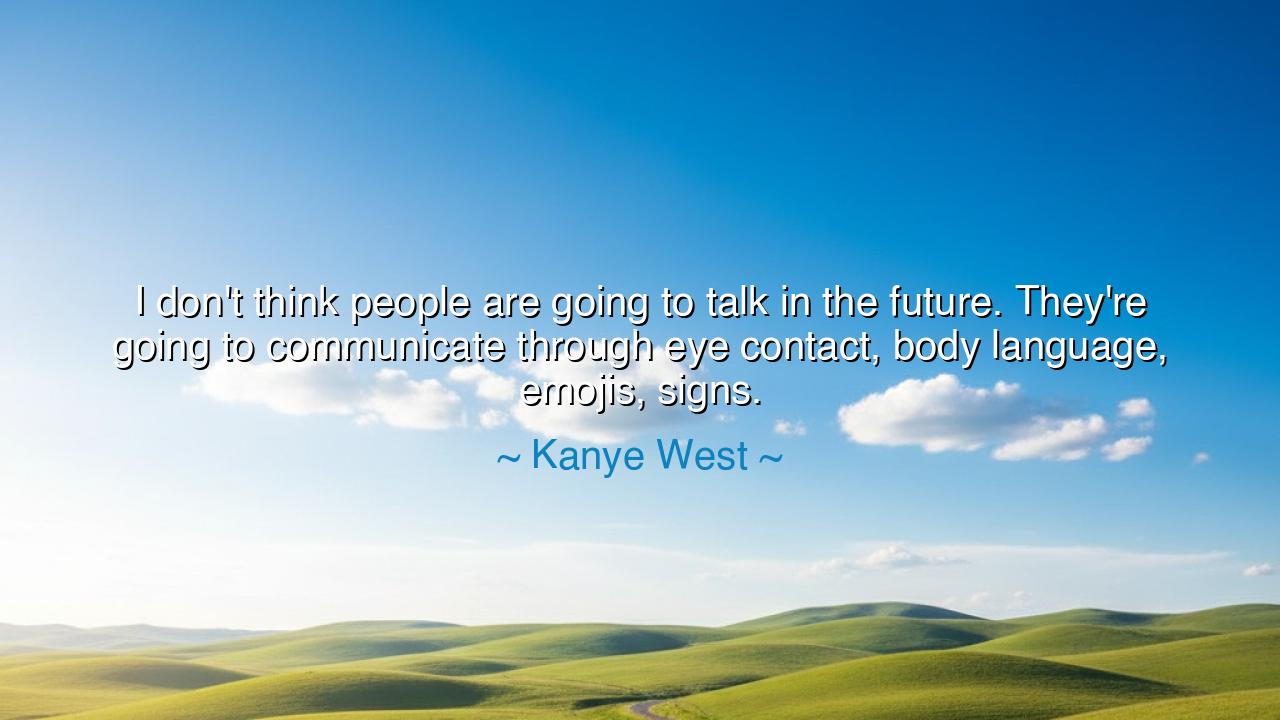
I don't think people are going to talk in the future. They're
I don't think people are going to talk in the future. They're going to communicate through eye contact, body language, emojis, signs.






In a world filled with the sounds of constant communication, there is a deep and transformative shift underway—one that Kanye West foresaw when he said, "I don't think people are going to talk in the future. They're going to communicate through eye contact, body language, emojis, and signs." This statement speaks to the evolution of human interaction, where the power of spoken language may give way to a more visual, intuitive, and immediate form of connection. West’s words challenge us to think about the future of communication, one that transcends the barriers of words and taps into the universal language of non-verbal cues and symbols.
The ancients understood that communication was not limited to speech alone. In ancient Greece, Sophocles, in his tragic plays, often used the eyes of his characters to convey deep emotions and conflict. The Greeks believed that the soul could be seen through the eyes, and in their theater, body language spoke volumes about the inner struggles and desires of the characters. This reflects a truth that has always existed in human interaction: sometimes, the most profound communication happens not through words, but through the gestures, glances, and actions that transcend language. Just as Sophocles used the eyes and body to communicate powerful messages, West envisions a future where these modes of communication become the dominant language of the human race.
The Romans, too, were keenly aware of the power of non-verbal communication. The way a general stood before his troops, the stance of a statesman before the Senate, or the gaze exchanged between lovers were all seen as vital forms of expression. The Roman orator, Cicero, was a master of gesture, understanding that his physical movements and the expression of his eyes were as important as the words he spoke. He knew that the delivery of a speech could change the course of history, not just by the content of the words, but by the power of the unspoken language that accompanied them. In this way, the ancients recognized the potential of non-verbal forms of communication to carry as much, if not more, weight than spoken words.
In modern times, the rise of technology has only enhanced the evolution of non-verbal communication. The advent of social media, emojis, and digital expressions has made it clear that we are moving toward a future where words are no longer the primary means of interaction. Emojis themselves are a testament to this shift—tiny, simple symbols that convey complex emotions and ideas, transcending the need for long, drawn-out explanations. What began as a way to supplement text has now become a universal language of its own. West’s prediction is not just a reflection of modern trends but a recognition that, as technology evolves, so too does the way we relate to one another.
The lesson in Kanye West’s words is not just about the changing tools of communication but about the deeper nature of connection itself. The rise of non-verbal communication reminds us that humans have always sought ways to understand one another, often beyond the limitations of spoken language. In ancient times, oral traditions flourished, but even then, the power of silence, eye contact, and the shared gaze spoke volumes. As we move into the future, we must remember that true connection is not limited by words, but exists in the spaces between them—the understanding and empathy that are transmitted through a look, a touch, or a symbol.
As we adapt to this new age, we should reflect on the role of intention and authenticity in communication. In a world where words can be misinterpreted, emojis can be misused, and body language can be misunderstood, we must cultivate a deeper sense of awareness. The ancient philosophers taught that true wisdom comes from understanding not just the words we speak, but the silence that surrounds them. Just as the eyes can reveal more than any spoken phrase, so too can our actions and gestures speak the truth of our hearts.
In our own lives, we must strive to be mindful of how we communicate—whether through words, looks, or symbols. As West suggests, the future may hold many new ways of connecting, but it will always be the intention behind those connections that truly matters. Let us cultivate the art of listening with our eyes, speaking with our presence, and connecting with the soul of those around us, whether through words or the silence that often speaks louder than any speech. In the end, it is not the technology or the medium we use, but the depth of our connection and the authenticity with which we communicate that will define the future of humanity.






AAdministratorAdministrator
Welcome, honored guests. Please leave a comment, we will respond soon